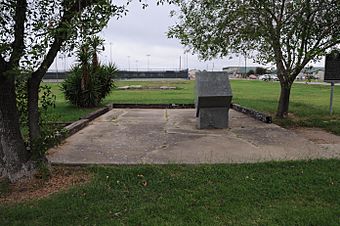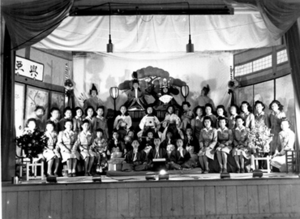Crystal City Internment Camp facts for kids
Quick facts for kids |
|
|
Crystal City Internment Camp
|
|

Camp memorial
|
|
| Location | Roughly bounded by Airport Drive, Popeye Lane, North 7th & North 12th Avenues, Crystal City, Texas |
|---|---|
| Built | 1943 |
| NRHP reference No. | 14000474 |
| Added to NRHP | August 1, 2014 |
The Crystal City Internment Camp was a special place near Crystal City, Texas. During World War II, it held families of Japanese, German, and Italian descent. It was a detention facility, meaning a place where people were held.
The camp was officially called the Crystal City Alien Enemy Detention Facility. It was run by the Immigration and Naturalization Service (INS). It was first meant for Japanese families. Later, German families were also sent there. Many people held at the camp were actually American citizens who were born in the U.S.
During World War II, over 127,000 U.S. citizens were held in camps like this. The Crystal City camp was one of the main places for families. At the time, these camps were called "internal security" measures. But now, we know they were "unjust and motivated by racism." This means they were unfair and based on prejudice, not real military needs. The camp opened in December 1943 and closed on February 11, 1948. At its busiest, in December 1944, it held 3,374 people.
Contents
Why Was the Camp Built?
The Crystal City camp was one of the largest camps in Texas. It was about 110 miles south of San Antonio. Before the war, this area was a camp for farm workers. It was built by the Farm Security Administration (FSA) for people who came to grow spinach.
When World War II began, thousands of Japanese and German people living in the U.S. were arrested. This included both U.S. citizens and people from other countries. They were separated from their families. The old farm worker camp was given to the INS. This allowed these people, called "enemy aliens," to be reunited with their wives and children.
The first group of 35 German families arrived on December 12, 1942. Women and children from another camp, Camp Seagoville, came in early 1943. Their husbands and fathers were moved to Crystal City from other camps. By August 1944, the camp held 2,104 people of Japanese background and 804 people of German background. They lived in separate areas based on their ethnicity.
Who Was Held at the Camp?
People from Latin America
Early in the war, the U.S. government worked with countries in Latin America. They wanted to round up German and Japanese people living there. These people were then sent to the U.S. When they arrived in New Orleans, Louisiana, the men were arrested. They were accused of trying to enter the U.S. illegally. They were sent to different detention centers. Their wives and children followed later. They were told they were volunteering, but most families had no other choice.
Once in the U.S., these people could be sent to Germany or Japan. This was part of a program to exchange them for American citizens and diplomats stuck in enemy countries. This exchange program did not last long. It changed into a "repatriation" program. This meant German and Japanese people and their families were sent back to Germany and Japan. This included many children who had never even been to those countries.
Most of the Latin American people in Crystal City were sent to Germany and Japan after the war. However, some Japanese Peruvians were allowed to stay in the U.S. after a long legal fight. Nearly 1,500 Latin American Japanese were held in Crystal City. Almost 80% of them came from Peru. The 234 Latin American Germans came from countries like Bolivia, Colombia, and Guatemala.
German and Japanese Americans
The Crystal City camp also held Japanese and German Americans. These were people who had lived in many different parts of the United States. Many non-citizen Japanese and German men were arrested right after the attack on Pearl Harbor. They were held in various detention sites. Later, they were moved to Crystal City to be with their families.
The first German Americans arrived in December 1942 from Ellis Island. The first Japanese Americans were women and children. They came to Crystal City from Seagoville in March 1943. More Japanese Americans arrived by train from other camps. Most Japanese Americans came from the West Coast. German Americans came from many different places across the U.S.
Life Inside the Camp

The idea of holding entire families was new during World War II. In Crystal City, German and Japanese people lived in separate sections. Camp officials said this helped them keep an eye on both groups. The Crystal City Internment Camp received many people from other camps. This made the camp very crowded.
The German section had its own bakery, dining hall, and community hall. Large German families were given their own small houses. These houses had showers, kitchens, bathrooms, and hot water. A weekly newsletter in German, called Unter uns, was also published.
The Japanese section had a Japanese school and American schools. It also had a citrus orchard and places for fun. There were tennis courts, basketball courts, a football field, and a swimming pool. Japanese families lived in houses with running water and iceboxes.
Children in the Camp
Most of the children at Crystal City were American citizens. Their parents were not citizens. Each child received a quart of milk every day. Three schools were set up: the German School, the Japanese School, and the American Schools. The American Schools included Federal Elementary and Federal High School. These schools taught all the basic subjects required by Texas schools.
The American School started in January 1943. Over 1000 students went there before it closed in June 1946. Most students were Japanese-American. Many of them later went to universities in the United States. The parents of German-American students often preferred to send their children to the German School. German-American children who moved from the American School to the German School sometimes found it hard. This was because they could not speak German very well. Both the German School and the American Schools had about 350 students each. The Japanese School taught about 300 students. Its lessons were like those in Japan, focusing on Japanese morals and physical education.
Schools Close Down
On January 24, 1946, an official named J. L. O'Rourke closed the German and Japanese schools. He ordered all remaining students to go to the American schools. The American schools then closed on June 28, 1946. By then, only 16 Japanese students were still in Crystal City with their parents. Many people had already been sent back to their home countries after the war ended.
The INS did not allow the Japanese students to go to public schools near Crystal City. Because of this, and with no other options, the remaining Japanese families reopened their Japanese School.
The Camp Closes
In 1945, as the war ended, leaders met in Mexico City. They decided that people could be removed from the Americas if they were a "prejudice" to security. In September, President Harry S. Truman allowed the deportation of "enemy aliens" from the U.S. By the end of 1945, the camp still held 3,374 people. This included 2,371 Japanese and 997 Germans, plus six Italians.
By December, 660 Japanese Peruvians were sent to Japan. Their home country, Peru, would not let them return. Also, 600 Japanese Hawaiians went back to their homes. By June 1946, most of the remaining German and Japanese people were deported. This included another 900 Japanese Peruvians.
Crystal City stayed open to hold Japanese Peruvians who did not want to be sent back. With help from a lawyer named Wayne M. Collins, 364 people filed a lawsuit. After two years, they were allowed to leave and work at Seabrook Farms in New Jersey. The Crystal City Internment Camp officially closed when they were released on February 11, 1948.
What Is Left Today?
The land where the camp stood is now owned by the local school district. A granite stone marks the spot. It says "World War II Concentration Camp, 1943-1946." This stone was put there in November 1985.
The Texas Historical Commission dug up parts of the site in April 2013. They were preparing to add the site to the National Register of Historic Places. This listing was approved on August 1, 2014.
Notable People Held Here
- Yoshiaki Fukuda (1898–1957), a religious leader and missionary.
- Major Arthur D. Jacobs USAF, who wrote about his time in the camp.
- Ishiko Mori (1899–1972), a doctor and writer.
- Motokazu Mori (1890–1958), a surgeon and poet.
- Isamu Shibayama (1930–2018), a civil-rights activist. He fought for the rights of Latin Americans of Japanese background.
- Tokiji Takei (1903–1991), a Japanese poet and essayist.
- Edison Uno (1929–1976), a Japanese-American civil-rights advocate.



